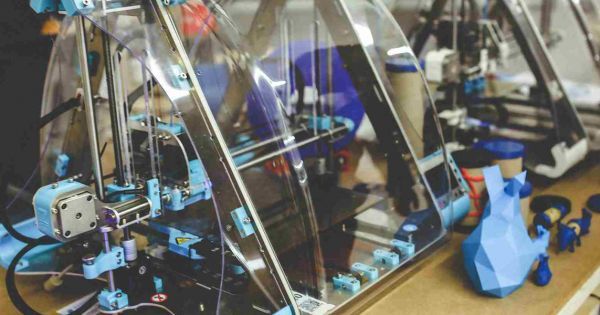By NASA.
The iconic scene in the movie Terminator where T-1000 robot heals itself of the bullet holes has now become a technological reality.


To make robots more cooperative and have them perform tasks in close proximity to humans, they must be softer and safer. A new actuator developed by Harvard researchers generates movements similar to those of skeletal muscles using vacuum power to automate soft, rubber beams.
Like real muscles, the actuators are soft, shock absorbing, and pose no danger to their environment or humans working collaboratively alongside them or the potential future robots equipped with them. The work was reported June 1 in the journal Advanced Materials Technologies.
The new actuators could pave the way for entirely soft-bodied robots that are safer than their conventional rigid counterparts.
Terahertz radiation, or T-rays, can do some really incredible stuff. It can be used to scan for tumors and bombs build ultrafast wireless networks and see through solid objects. As an imaging technology, however, T-ray cameras have always had a resolution limitation. Well, they used to. Researchers at the University of Exter has developed a new terahertz camera that can see at a microscopic level — and they want to use it to find defects in microchips.
This breakthrough kind of changes the game for terahertz imaging. The radiation has always been able to look through solid objects without damaging them — which is why it’s frequently used in the art world to look past the surface layer of various masterpieces — but resolution limitations kept it from being used to diagnose broken computer chips.
Project lead Rayko Stantchev says his team has effectively doubled the technology’s resolution, creating a proof-of-principle prototype that can see a microscopic image printed on a circuit board obscured by a thick silicon wafer. “With our device you could test the quality of microchips that have buried under optically-opaque materials,” Stantchev says. “Allowing you to tell if a hidden chip is broken without having to open it up.”

Nice!
Metal organic vapor phase deposition on etched 4-inch-diameter sapphire wafers is used to create low-defect-density gallium nitride templates.

Visible emitting LEDs based on gallium nitride (GaN) materials have made tremendous progress since their initial development in the early 1990s. Indeed, these LEDs are now in everyday use in many applications, e.g., for solid state lighting, and for backlighting in televisions and smartphones. LED technology, however, also has several inherent problems. These include decreasing efficiency under high injection current (droop), color change with increasing current, and poor efficiency in the green and yellow parts of the spectrum. These problems are associated with the natural polar (0001) crystal plane of wurtzite GaN, on which commercial LEDs are based, with the use of ‘c-plane’ sapphire substrates.

Patents filed on many pre-existing 3D printing processes are about to expire. As this occurs, it will bring on a new era in 3D printing. Machinery and material costs will plummet, and the quality of prints will increase.
An important shift is occurring in the 3D printing world: patents are expiring. Patents filed on pre-existing industrial printing processes, especially those filed at the turn of the century, have already expired or are set to expire in the coming years.
Take, for example, the case of Fused Deposition Modeling (FDM). The patent on FDM expired in 2009. As a result, prices for FDM printers dropped from over $10,000 to less than $1,000, which caused consumer-friendly 3D printer manufacturers– like MakerBot and Ultimaker– to pop up.


Researchers at MIT are seeking to redesign concrete — the most widely used human-made material in the world — by following nature’s blueprints.
In a paper published online in the journal Construction and Building Materials, the team contrasts cement paste — concrete’s binding ingredient — with the structure and properties of natural materials such as bones, shells, and deep-sea sponges. As the researchers observed, these biological materials are exceptionally strong and durable, thanks in part to their precise assembly of structures at multiple length scales, from the molecular to the macro, or visible, level.
From their observations, the team, led by Oral Buyukozturk, a professor in MIT’s Department of Civil and Environmental Engineering (CEE), proposed a new bioinspired, “bottom-up” approach for designing cement paste.


A new cheaper way in creating magnets.
US researchers have created a powerful permanent magnet out of iron and nitrogen, two plentiful cheap materials, as part of a programme to cut the need for ‘rare earth’ metals.
It is only a tiny sample, a film 500nm thick, but it is the real thing.
“To the best of our knowledge, this could be the first experimental evidence of the existence of a giant saturation magnetisation, an obviously large coercivity, with a magnetic energy product of up to 20 MGOe, in a bulk-type FeN sample.” said the team in ‘Synthesis of Fe16 N2 compound free-standing foils with 20MGOe magnetic energy product by nitrogen ion-implantation’, a Nature Scientic Reports paper written by a team from the University of Minnesota, Los Alamos National Laboratory and Oak Ridge National Laboratory.

New graphene transistor makes for a faster processor.
Scientists have developed a new type of graphene-based transistor and using modelling they have demonstrated that it has ultralow power consumption compared with other similar transistor devices. The findings have been published in a paper in the journal Scientific Reports. The most important effect of reducing power consumption is that it enables the clock speed of processors to be increased. According to calculations, the increase could be as high as two orders of magnitude.
“The point is not so much about saving electricity — we have plenty of electrical energy. At a lower power, electronic components heat up less, and that means that they are able to operate at a higher clock speed — not one gigahertz, but ten for example, or even one hundred,” says the corresponding author of the study, the head of MIPT’s Laboratory of Optoelectronics and Two-Dimensional Materials, Dmitry Svintsov.